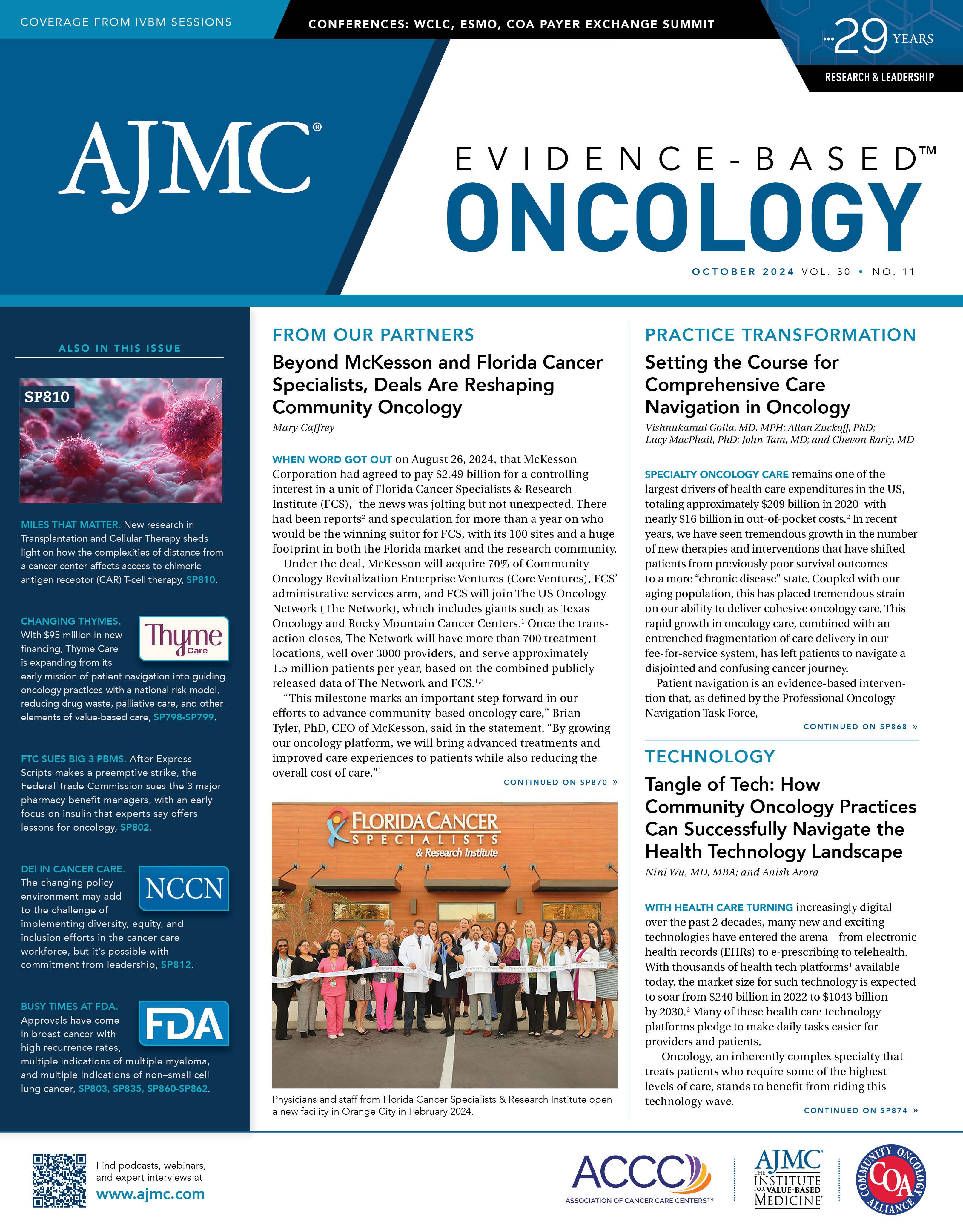
- Center on Health Equity & Access
- Clinical
- Health Care Cost
- Health Care Delivery
- Insurance
- Policy
- Technology
- Value-Based Care
Setting the Course for Comprehensive Care Navigation in Oncology
Specialty oncology care remains one of the largest drivers of health care expenditures in the US, totaling approximately $209 billion in 20201 with nearly $16 billion in out-of-pocket costs.2 In recent years, we have seen tremendous growth in the number of new therapies and interventions that have shifted patients from previously poor survival outcomes to a more “chronic disease” state. Coupled with our aging population, this has placed tremendous strain on our ability to deliver cohesive oncology care. This rapid growth in oncology care, combined with an entrenched fragmentation of care delivery in our fee-for-service system, has left patients to navigate a disjointed and confusing cancer journey.
Vishnukamal Golla, MD, MPH | Image: Duke Department of Surgery

Allan Zuckoff, PhD | Image: Evolent

Lucy MacPhail, PhD | Image: LinkedIn

John Tam, MD | Image: Evolent

Chevon Rariy, MD | Image: PRNewswire

Patient navigation is an evidence-based intervention that, as defined by the Professional Oncology Navigation Task Force, seeks to offer “individualized assistance to patients, families, and caregivers to help overcome barriers and facilitate timely access to quality health and psychosocial care from prediagnosis through all phases of the cancer experience.”3 An oncology navigation program provides a foundation to help transform the patient’s cancer journey and in doing so addresses significant gaps in quality that include reducing disparities in care, driving down avoidable inpatient and emergency care utilization, and improving the patient experience with goal-concordant care.4-6 In helping address these gaps in care and improve the delivery of patient-centered cancer care, navigation programs have achieved meaningful financial outcomes, driving down total cost of care for these patients.7
In this article, we lay out the challenges faced in oncology care delivery, including health care policy and regulatory headwinds and tailwinds impacting their success. We then describe the design elements critical to the creation of a successful oncology navigation program.
Current Challenges in Oncology Care
Patients diagnosed with cancer and their caregivers face significant health care system barriers that impact their ability to receive timely access to oncology care, address health-related social needs (HRSNs), and manage both the oncologic and psychosocial symptoms that impact health outcomes.
One of the predominant challenges remains the fragmentation in care coordination in the fee-for-service US health care system. Although referrals from primary care providers (PCPs) to specialists are an integral component of collaboratively managed care in this country, patients, PCPs, and specialists remain highly frustrated by the process.8 There is a need for a working referral process that reduces burdens on the co-management of care between PCPs and specialists; however, this goal remains elusive. Fragmentation extends into data and technology, where patient information is not integrated across electronic medical records (EMRs), further limiting the creation of a cohesive, integrated treatment plan.
Additional challenges arise from continued pressures to increase clinical production amid decreased CMS reimbursements and health care system financial concerns. This strain has translated into larger patient panels, leaving physicians little time to adequately uncover and address HRSNs or have meaningful goals-of-care conversations that can significantly impact treatment plans.
Health Care Policy and Market Dynamics
Navigation programs are well positioned to address the fragmentation and other significant challenges faced by oncology patients. At the same time, there have been inherent challenges in the implementation, scalability, and sustainability of these models.
In the past, regulatory barriers to integrating patient navigation services into our fee-for-service payment system prevented Medicare, Medicaid, and commercial insurance from providing reimbursement to practices or systems that delivered navigation services.9 Fortunately, important recent changes in health care policies and regulations signal a brighter future for patient navigation programs.
Creation of 4 new CPT codes (G0023, G0024, G0140, and G0146) for patient navigation services was announced in the CMS 2024 Medicare Physician Fee Schedule final rule.10 Practices and health systems previously reluctant to invest resources in such programs now have financial incentives to build them. Importantly, reimbursement also helps cover other critical elements of navigation, including assessment of social determinants of health and integrating community health resources.
In 2024, the Biden Cancer Moonshot announced the expansion of coverage of patient navigation into a few commercial health plans.11 We see further progress with the latest iteration of the Center for Medicare and Medicaid Innovation’s oncology value-based payment model, Enhancing Oncology Model,12 which has continued to support navigation resources for practices.
All in all, significant tailwinds support the growth of navigation programs, particularly in oncology. In the next few sections, we will dive into the impact on patients and principles of design for impactful oncology navigation programs.
Design of an Innovative and Sustainable Oncology Navigation Program
An oncology navigation program must support the uniqueness of each patient’s cancer journey and consider the HRSNs and values that are important to each patient. While it is not a one-size-fits-all care delivery model, there are a few principles that are integral when developing an impactful oncology navigation program:
- Targeted, early patient identification
- Patient engagement at scale
- Impact through clinical and social support
- Seamless integration into the patient’s ecosystem and coordination of care across providers
We will tackle each of one of these design elements but will start with the foundation for many of these programs: the navigators themselves.
Navigators
Oncology navigation services can encompass both clinical and nonclinical aspects to provide comprehensive patient education, symptom management, early palliative care referrals when appropriate, access to social services, and care coordination. These are provided while incorporating treating providers as an extension of care without overloading their workflows or disrupting their usual daily care delivery. Clinical navigators can provide informed guidance throughout the cancer care continuum, from suspicion of cancer through treatment, survivorship, and palliative care and hospice.
They offer personalized guidance across the patient’s treatment journey, ensuring that they understand their diagnosis, treatment options, and how to manage adverse effects. Nonclinical navigators can focus on identifying and addressing psychosocial needs and HRSNs, connecting patients to essential resources, such as transportation and financial assistance, and helping them establish an effective support network. By maintaining regular check-ins and providing emotional support, care navigators help close care gaps and ensure that patients receive holistic care throughout their treatment.
Targeted, Early Patient Identification
While many variations of navigation programs exist, too often they focus on discrete elements of the patient journey, such as active treatment. However, this contributes to further fragmentation and leaves the patient unsupported during their cancer diagnosis, when they could use the most support.
It is important to ensure that navigation services are available to the patient as early as the suspicion of cancer or first diagnosis of cancer, which often occurs when patients are still being managed by their primary care physician prior to the referral to an oncologist. This period is a “gray zone” fraught with questions and logistical pitfalls for the patient. Navigators can play a critical role during this period in supporting the patient with coordination needs, such as scheduling the initial testing and collecting all the necessary biopsy results as well as diagnostic and lab tests, so that an oncologist has information to develop a treatment plan. Additional areas of support include guidance to the PCP on selecting an oncologist best matched to a patient’s needs and preparing the patient for their first visit with the oncologist.
Impact Through Clinical and Social Support
In our experience, navigation programs present a significant opportunity to impact patient outcomes as well as costs of care. Statistics indicate that 52% of emergency department visits and 23% of hospitalizations related to cancer could be avoidable, and that 47% of patients who died within 1 month of their diagnosis received aggressive but possibly ineffective treatments for their incurable cancer.4-6 These findings reinforce the impact that clinical and social support can have for these patients.
Navigators help patients understand their cancer and the treatments prescribed, educating them about what to expect and how to prepare for oncologist and treatment visits. They can help patients better understand their prognosis and how the proposed treatment plans align with what matters most to them so they receive more goal-concordant care. Active clinical monitoring and proactive planning for adverse effects and symptom exacerbation reduce the toll of treatment, supporting adherence and minimizing unnecessary and disruptive emergency department visits and inpatient episodes.
Navigation programs can also reduce the burden placed on patients and their caregivers by a fragmented and costly health care system. Navigators support coordination across specialty physicians and provider practices, help with making provider and treatment appointments, and facilitate the sharing of information between oncologists and primary care physicians. They also identify resources to address health-related social needs, including lack of transportation, housing insecurity, and financial toxicity.
As patients progress along their cancer journeys, the kinds of support they most need also evolve. For patients who reach survivorship, ensuring their own awareness of their survivorship plan and sharing it with the primary care provider promotes adherence to the plan and optimal posttreatment care. With patients whose cancer advances, navigators offer sensitive and skillful conversations to facilitate comprehensive advance care planning and access to palliative or hospice care as the end of life approaches.
Seamless Integration Into the Patient’s Ecosystem
A patient navigation program should be purpose-built to work with the existing ecosystem of providers and support network to mitigate any further exacerbation of fragmentation. The program should closely collaborate with provider practices and other navigation resources while also partnering with the health plan’s case management team. Engaging and collaborating with providers in areas such as symptom management and how to escalate cases when their patients experience concerning symptoms can ensure that patients receive consistent messages. Additionally, it is essential to share key data with primary care and oncology providers throughout the patient journey: survivorship plans, advance care plans, and executed advance directives as well as post–emergency department discharge information, for example.
Finally, leveraging a close partnership with health plan case management so as not to cause “resource fatigue” for patients and prevent duplication of services is key. Working in concert with the existing resources creates a true whole-person health experience for patients in a navigation program.
Patient Engagement at Scale
To ensure patient engagement at scale, navigation programs must be able to integrate advanced technology to provide customized support to the individual patient while scaling to support the population. These key technology-related elements include a user-friendly interface that offers seamless access to personalized care plans and educational resources and provides the ability to integrate with telehealth consultations. Additionally, AI-driven analytics can provide predictive insights to facilitate proactive outreach, identifying high-risk patients and tailoring interventions. Integration with EMRs, wearables, and other data sources ensures comprehensive, real-time health monitoring and expands the reach of the program into obtaining the right information at the right time. Interactive features, such as virtual care coordinators, enhance patient support and engagement. Additionally, escalated outreach by navigators, including coordination to facilitate equitable access to necessary services, helps to drive a holistic, patient-centric approach.
Conclusion
We have come a long way in building on the vision of Harold P. Freeman, MD, who launched the first patient navigation program in the Harlem Hospital Center in New York, New York. His vision to improve support for cancer patients across the health care continuum—especially those particularly vulnerable to disparities—still holds true today. Oncology navigation plays a pivotal role in delivering the “quadruple aim” of improving the patient experience, population health outcomes, the healthcare provider experience and reducing costs). And as the field of oncology continues to evolve, dedicated navigation services remain an indispensable component of comprehensive cancer care.
Author Information
All authors are employed by Evolent. For correspondence, contact Vishnukamal Golla, MD, senior medial director for innovation and value transformation at Evolent Health, 1812 N. Moore St., Suite 1705, Arlington, VA 22209. Email: vgolla@evolent.com.
Funding
There is no funding source.
References
1. Cancer trends progress report. National Cancer Institute. March 2024. Accessed September 7, 2024. https://progressreport.cancer.gov
2. Kuehn BM. Cancer care creates substantial costs for US patients. JAMA. 2021;326(22):2251. doi:10.1001/jama.2021.21119
3. Oncology navigation standards of professional practice. Clin J Oncol Nurs. 2022;26(3):E14-E25. doi:10.1188/22.CJON.E14-E25
4. Alishahi Tabriz A, Turner K, Hong YR, Gheytasvand S, Powers BD, Elston Lafata J. Trends and characteristics of potentially preventable emergency department visits among patients with cancer in the US. JAMA Netw Open. 2023;6(1):e2250423. doi:10.1001/jamanetworkopen.2022.50423
5. Brooks GA, Jacobson JO, Schrag D. Clinician perspectives on potentially avoidable hospitalizations in patients with cancer. 2015;1(1):109-110. doi:10.1001/jamaoncol.2014.155
6. Sineshaw HM, Jemal A, Ng K, et al. Treatment patterns among de novo metastatic cancer patients who died within 1 month of diagnosis. JNCI Cancer Spectr. 2019;3(2):pkz021. doi:10.1093/jncics/pkz021
7. New data shows Thyme Care navigation program reduces total cost of care for cancer patients by nearly 20%. News release. Thyme Care. October 31, 2023. Accessed August 16, 2024. https://www.prnewswire.com/news-releases/new-data-shows-thyme-care-navigation-program-reduces-total-cost-of-care-for-cancer-patients-by-nearly-20-301972537.html
8. Mehrotra A, Forrest CB, Lin CY. Dropping the baton: specialty referrals in the United States. Milbank Q. 2011;89(1):39-68. doi:10.1111/j.1468-0009.2011.00619.x
9. Garfield KM, Franklin EF, Battaglia TA, et al. Evaluating the sustainability of patient navigation programs in oncology by length of existence, funding, and payment model participation. Cancer. 2022;128(suppl 13):2578-2589. doi:10.1002/cncr.33932
10. CMS. Final rule: revisions to payment policies under the Medicare Physician Fee Schedule, Quality Payment Program and other revisions to Part B for CY 2024. November 16, 2023. Accessed January 19, 2024. https://www.cms.gov/medicare/medicare-fee-service-payment/physicianfeesched/pfs-federal-regulation-notices/cms-1784-f
11. Biden Cancer Moonshot announces expanded coverage for patient navigation in private health plans. News release. American Cancer Society Cancer Action Network. March 8, 2024. Accessed August 16, 2024. https://www.fightcancer.org/releases/biden-cancer-moonshot-announces-expanded-coverage-patient-navigation-private-health-plans-0
12. Enhancing Oncology Model. CMS. Accessed August 16, 2024. https://www.cms.gov/priorities/innovation/innovation-models/enhancing-oncology-model

Exploring Racial, Ethnic Disparities in Cancer Care Prior Authorization Decisions
October 24th 2024On this episode of Managed Care Cast, we're talking with the author of a study published in the October 2024 issue of The American Journal of Managed Care® that explored prior authorization decisions in cancer care by race and ethnicity for commercially insured patients.
Listen
Exploring Racial, Ethnic Disparities in Cancer Care Prior Authorization Decisions
October 24th 2024On this episode of Managed Care Cast, we're talking with the author of a study published in the October 2024 issue of The American Journal of Managed Care® that explored prior authorization decisions in cancer care by race and ethnicity for commercially insured patients.
Listen
2 Commerce Drive
Cranbury, NJ 08512
AJMC®
All rights reserved.